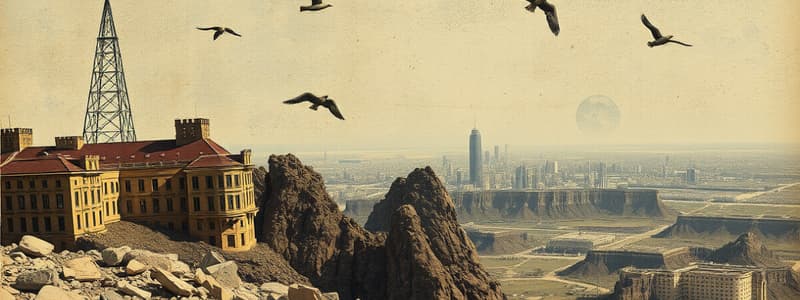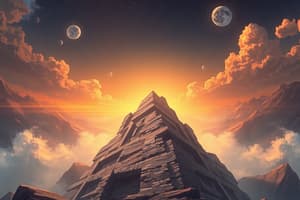Podcast
Questions and Answers
What is an earthquake?
What is an earthquake?
An earthquake is the vibration of earth produced by the rapid release of energy.
What are the differences between the focus and epicenter of an earthquake?
What are the differences between the focus and epicenter of an earthquake?
Focus is the point of earthquake origin below earth's surface directly below the epicenter; epicenter is the point of earthquake origin on the earth's surface.
What does the Elastic Rebound Hypothesis state?
What does the Elastic Rebound Hypothesis state?
Earthquakes are produced by the rapid release of elastic energy stored in rocks within earth's lithosphere.
What are aftershocks?
What are aftershocks?
What are foreshocks?
What are foreshocks?
What is a seismograph?
What is a seismograph?
What is a seismogram?
What is a seismogram?
What are the differences between body waves and surface waves?
What are the differences between body waves and surface waves?
What are the properties of P waves, S waves, and surface waves?
What are the properties of P waves, S waves, and surface waves?
How can you find the exact location of an earthquake epicenter?
How can you find the exact location of an earthquake epicenter?
What are the two scales used to measure earthquakes?
What are the two scales used to measure earthquakes?
What is a Richter scale?
What is a Richter scale?
What is Moment Magnitude?
What is Moment Magnitude?
What are 3 factors that affect the designs of buildings in earthquake-prone areas?
What are 3 factors that affect the designs of buildings in earthquake-prone areas?
What is liquefaction?
What is liquefaction?
What is a tsunami?
What is a tsunami?
What are 3 types of dangers caused by earthquakes?
What are 3 types of dangers caused by earthquakes?
Can scientists predict when earthquakes are going to occur?
Can scientists predict when earthquakes are going to occur?
Flashcards are hidden until you start studying
Study Notes
Earthquake Basics
- An earthquake is the vibration of the earth caused by the rapid release of energy, typically due to slippage along a fault.
- The focus is the origin point of an earthquake below the Earth's surface, while the epicenter is directly above it on the surface.
Faults
- A fault is a crack or break in the Earth's crust where seismic activity occurs.
Elastic Rebound Hypothesis
- Earthquakes occur when elastic energy stored in rocks is rapidly released upon reaching their breaking point.
Aftershocks and Foreshocks
- Aftershocks are smaller earthquakes that follow a significant quake.
- Foreshocks are minor quakes that occur before a major seismic event.
Seismographs and Seismograms
- Seismographs are devices used to record earthquake waves.
- Seismograms are the resulting records produced by seismographs.
Types of Seismic Waves
- Body waves travel through the Earth's interior.
- Surface waves travel along the Earth's outer layer.
Properties of Seismic Waves
- P waves (Primary waves): Fastest, travel through solid, liquid, and gas.
- S waves (Secondary waves): Slower, can only travel through solids.
- Surface waves: Slowest and most destructive, travel along the surface.
Determining Epicenter Location
- To locate an earthquake's epicenter, draw circles around three seismic stations based on their distance to the epicenter; the intersection point identifies the epicenter.
Earthquake Measurement Scales
- Two scales are used to measure earthquakes: the Richter scale and the Moment Magnitude scale.
- Moment Magnitude is more widely used due to its accuracy in describing effects near the epicenter.
Building Design Factors in Earthquake-Prone Areas
- Key factors include the nature of the foundational soil, building materials and design, and the intensity and duration of vibrations.
Liquefaction
- Liquefaction occurs when water-saturated sediments become unstable during an earthquake, potentially transforming solid ground into liquid, affecting populated areas.
Tsunami Formation
- A tsunami is a series of waves caused by underwater landslides or the vertical displacement of the ocean floor during an earthquake, capable of traveling at 700 mph in the open sea before slowing and increasing in height as they approach shore.
Additional Earthquake Hazards
- Earthquakes can cause structural failures, landslides, fires, ground subsidence, and disruption to essential services such as power and water.
Earthquake Prediction
- Scientists cannot predict specific earthquakes but can make long-term estimates based on historical "seismic gaps" in areas previously prone to earthquakes.
Studying That Suits You
Use AI to generate personalized quizzes and flashcards to suit your learning preferences.




